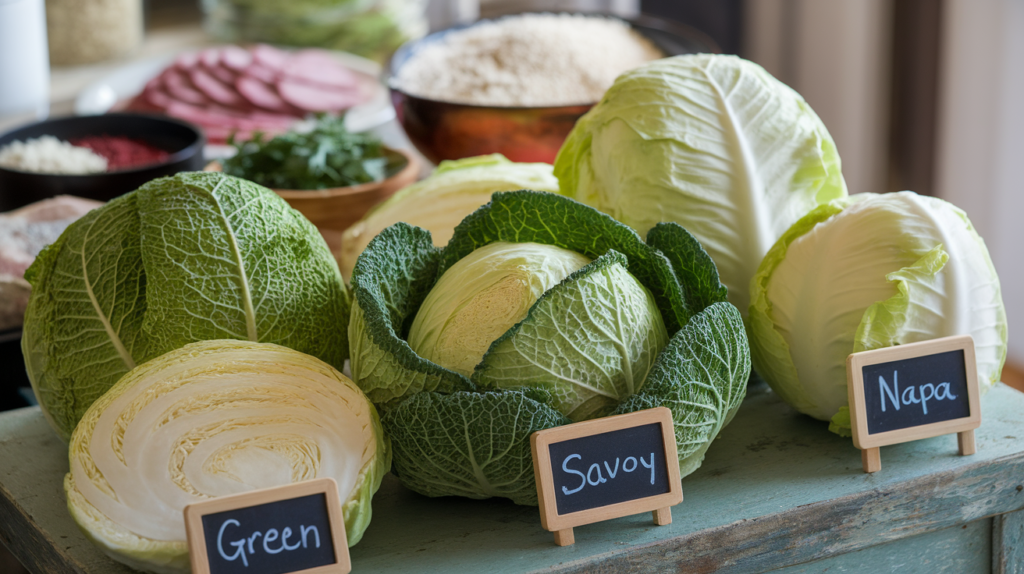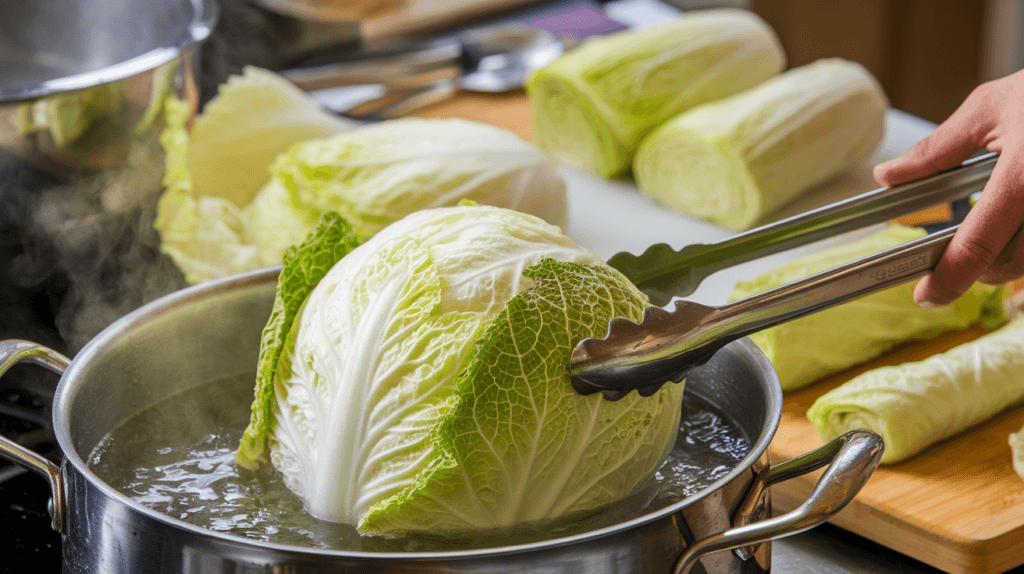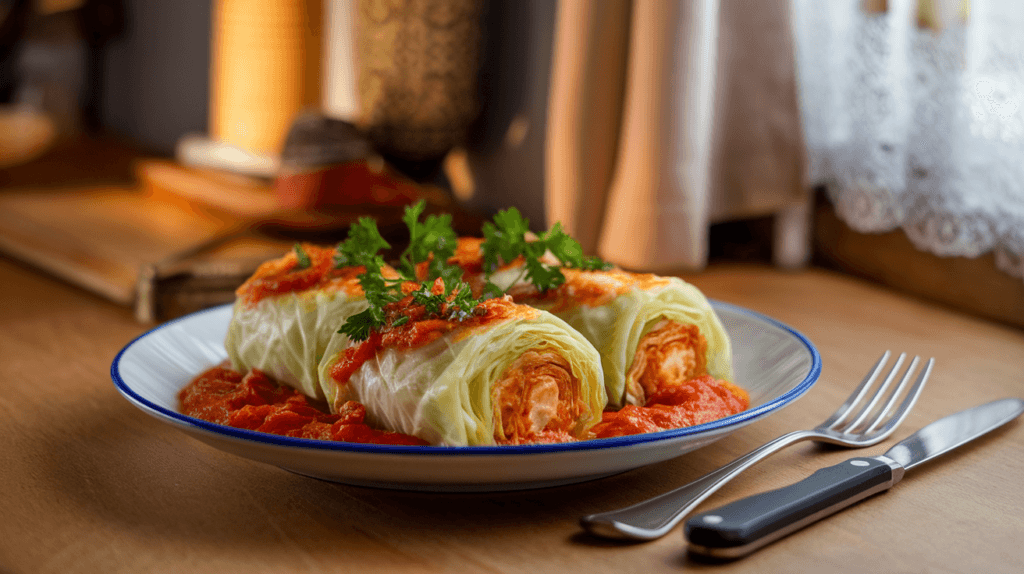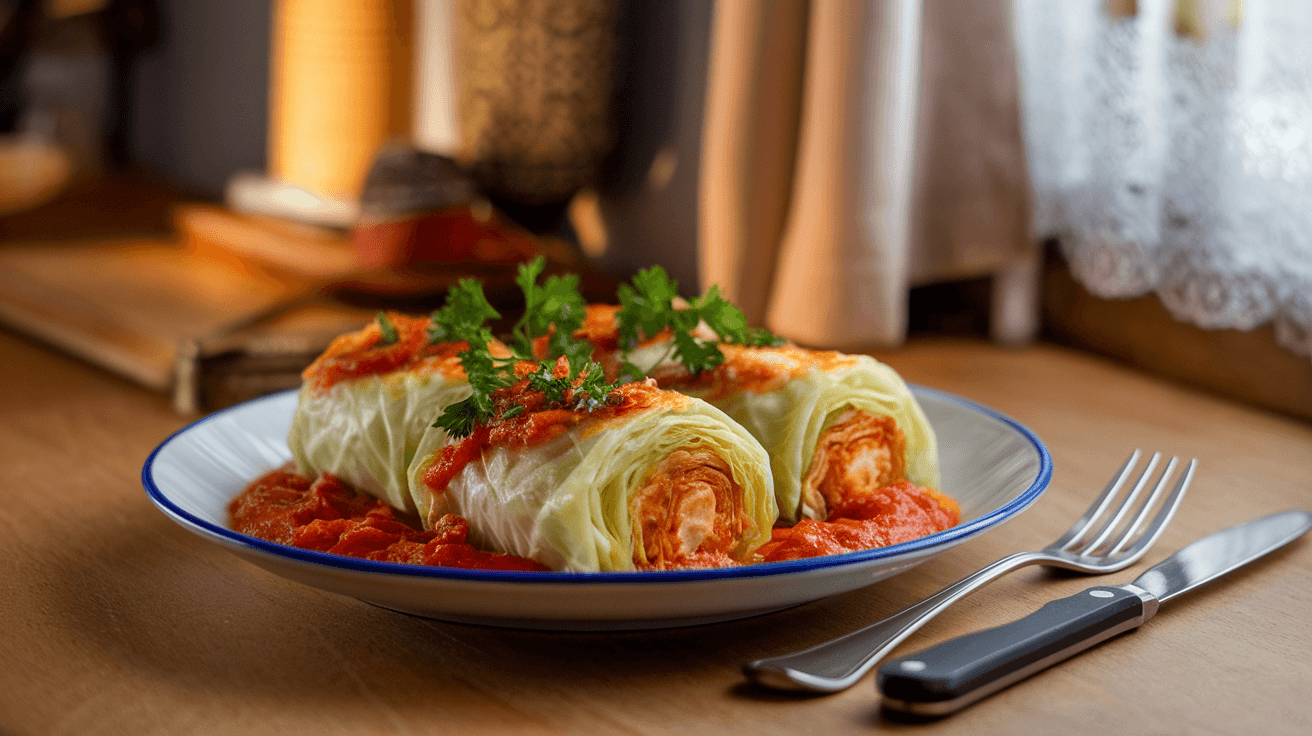Introduction
Cabbage rolls are a culinary delight cherished across many cultures, from Eastern European stuffed cabbage to Asian-inspired rolls. These hearty dishes combine savory fillings with tender cabbage leaves for a comforting, flavorful experience.
However, not all cabbage is created equal when it comes to making the perfect cabbage roll. Many people wonder, what is the best type of cabbage for cabbage rolls? Choosing the right type of cabbage ensures the leaves are pliable, flavorful, and hold the filling without tearing. In this guide, we’ll answer what is the best type of cabbage for cabbage rolls, explore the characteristics of the best cabbage for rolls, highlight top cabbage varieties to consider, and share preparation tips to make your next batch of cabbage rolls a success.

Characteristics of a Perfect Cabbage for Rolls
Not all cabbage varieties are suitable for making cabbage rolls. The right type of cabbage has specific characteristics that make it easy to work with and enhance the overall flavor of the dish. Here are the key factors to look for:
Leaf Size and Flexibility
Large, wide leaves are ideal for cabbage rolls as they can easily wrap around generous amounts of filling without breaking. But what is the best type of cabbage for cabbage rolls to achieve this? Flexibility is equally important. The leaves should be pliable enough to fold and roll without tearing, which is often achieved through preparation methods like blanching or freezing.
Texture Considerations
The texture of the cabbage leaves plays a crucial role. Leaves that are too thick can feel tough and chewy, while overly thin leaves may rip under the weight of the filling. A balance is necessary, where the cabbage is tender yet sturdy enough to hold its shape during cooking.
Flavor Profile for Cabbage Rolls
The flavor of the cabbage should complement the filling without overpowering it. Mildly sweet and earthy cabbages tend to pair well with the savory and spiced mixtures used in traditional cabbage rolls. Varieties like green cabbage or Savoy cabbage offer the perfect neutral base.
By understanding these characteristics, you can confidently select a cabbage variety that suits your culinary needs and ensures successful cabbage rolls every time.
The Top Types of Cabbage for Cabbage Rolls
When it comes to making cabbage rolls, many cooks ask, what is the best type of cabbage for cabbage rolls? Certain cabbage varieties stand out for their suitability. Below are the top types of cabbage that are perfect for creating tender and flavorful rolls.
Green Cabbage
Green cabbage is the most commonly used variety for cabbage rolls. Its large, uniform leaves and sturdy texture make it easy to work with. When blanched, the leaves become tender and pliable, perfect for rolling. The flavor of green cabbage is mild, which pairs beautifully with a wide range of fillings, from savory meats to vegetarian options.
Savoy Cabbage
Savoy cabbage is another excellent choice, known for its crinkled, textured leaves. These leaves are naturally softer and more flexible than green cabbage, requiring less preparation. The slightly sweet and nutty flavor of Savoy cabbage adds depth to cabbage rolls, making it a favorite for many chefs. Its aesthetic appeal also makes it a great choice for presentation.
Napa Cabbage
For those looking for a lighter and more delicate option, Napa cabbage is an ideal candidate. Its long, oblong leaves are tender and require minimal preparation. While it’s less traditional for European-style cabbage rolls, it’s widely used in Asian-inspired rolls and fusion recipes. The mild flavor of Napa cabbage allows the filling’s spices and ingredients to shine.
Each of these cabbages brings unique benefits to the table. Whether you prefer the classic choice of green cabbage or the elegant texture of Savoy cabbage, selecting the right variety will elevate your cabbage rolls to new heights.
How to Prepare Cabbage for Cabbage Rolls

Preparing cabbage correctly is a crucial step in making successful cabbage rolls. But first, what is the best type of cabbage for cabbage rolls to ensure proper preparation? Choosing the right cabbage ensures the leaves are soft, pliable, and ready to wrap around your delicious filling. Here are the most effective methods to prepare cabbage for cabbage rolls:
Blanching for Flexibility
Blanching is the most common method for softening cabbage leaves. To blanch:
- Bring a large pot of salted water to a boil.
- Remove the outermost leaves of the cabbage and rinse it thoroughly.
- Carefully place the cabbage head in the boiling water for 2-3 minutes.
- Peel off the softened outer leaves using tongs, then continue blanching the inner layers as needed.
Blanching ensures the leaves remain intact and flexible, making them easy to fold around the filling.
Freezing Method for Soft Leaves
If you prefer a hands-off approach, freezing the cabbage is a fantastic alternative. Here’s how:
- Remove the outer leaves and core the cabbage by cutting around the stem.
- Place the whole cabbage head in a freezer-safe bag and freeze overnight.
- Thaw the cabbage at room temperature or in the refrigerator before use.
Freezing breaks down the cellular structure of the leaves, making them naturally soft and pliable without the need for blanching.
Core Removal for Easier Rolling
Before softening the cabbage, remove its core to make separating the leaves easier. Using a sharp knife, cut out the tough, central stem at the base of the cabbage. This step simplifies the process of peeling off individual leaves without tearing them.
With these preparation methods, you’ll have perfectly tender cabbage leaves ready for rolling, ensuring your cabbage rolls are both delicious and structurally sound.
Factors to Consider When Selecting Cabbage
Choosing the right cabbage is essential for making perfect cabbage rolls. Many wonder, what is the best type of cabbage for cabbage rolls to achieve the best results? Beyond the type of cabbage, other factors can significantly impact the quality and flavor of your dish. Here’s what you should keep in mind when selecting cabbage:
Seasonal Availability
Cabbage is a cool-season vegetable, and its quality can vary depending on the time of year. For the freshest and most flavorful leaves:
- Look for cabbage in the fall or winter when it’s at its peak.
- In warmer months, check for varieties like Napa cabbage, which may still be in season.
Seasonally fresh cabbage tends to have better texture and taste, ideal for cabbage rolls.
Organic vs. Conventional Options
Both organic and conventionally grown cabbage can work well for cabbage rolls, but there are differences to consider:
- Organic cabbage is grown without synthetic pesticides and fertilizers, making it a great choice for those prioritizing sustainability and health.
- Conventional cabbage is often more affordable and widely available but may require extra washing to remove potential pesticide residues.
Whichever option you choose, ensure the cabbage is fresh and free from visible damage.
Storage and Freshness
The freshness of the cabbage directly impacts its flavor and texture. Follow these tips for selecting and storing cabbage:
- Choose cabbage heads that feel heavy for their size, with tightly packed leaves.
- Avoid cabbages with brown spots, wilting, or signs of rot.
- Store cabbage in the crisper drawer of your refrigerator, wrapped loosely in plastic or a perforated bag, for up to two weeks.
Fresh cabbage is easier to prepare and results in tastier rolls, making it worth the effort to select the best quality.
By considering these factors, you’ll ensure your cabbage rolls are as fresh, flavorful, and visually appealing as possible.
Tips for Perfect Cabbage Rolls Every Time

Making cabbage rolls can be an enjoyable and rewarding process with a few expert tips to ensure success. Whether you’re a first-timer or a seasoned cook, these tips will help you create perfectly rolled and flavorful cabbage rolls.
Choose the Right Filling
The filling is just as important as the cabbage itself. Traditional fillings often include a mix of ground meats, rice, and spices. To elevate the flavor:
- Use a combination of ground beef, pork, or turkey for a balanced taste.
- Add fresh herbs like parsley or dill for extra freshness.
- Experiment with vegetarian options using lentils, mushrooms, or quinoa as the base.
Don’t Overfill the Leaves
One common mistake is overfilling the cabbage leaves, which can cause them to tear or unravel during cooking. Place a small amount of filling in the center of each leaf, leaving room to fold and roll tightly. This ensures the rolls stay intact while cooking.
Layer and Secure Your Rolls
When placing the rolls in a pot or baking dish, layer them snugly to prevent them from unrolling during cooking. If needed, use kitchen twine or toothpicks to keep them secure. Cover the rolls with a flavorful sauce, such as tomato or broth-based sauces, to keep them moist and add richness.
Cook Low and Slow
Cabbage rolls are best cooked slowly to allow the flavors to meld and the cabbage to become tender. Whether baking, steaming, or simmering on the stovetop:
- Cook them at a low temperature (around 325°F/165°C for baking).
- Simmer for at least 1.5 to 2 hours for maximum tenderness and flavor.
Make Ahead for Better Flavor
Cabbage rolls taste even better the next day as the flavors deepen over time. Prepare them a day in advance, store them in the refrigerator, and reheat gently before serving. This is especially helpful for large gatherings or meal prepping.
By following these tips, you’ll take your cabbage rolls to the next level, creating a dish that’s sure to impress your family and guests alike.
Common Mistakes to Avoid When Making Cabbage Rolls
Even experienced cooks can encounter challenges when making cabbage rolls. Avoiding these common mistakes will help you achieve the best results every time:
Skipping the Softening Step
One of the most critical steps in preparing cabbage rolls is softening the leaves. Skipping this step can result in tough, inflexible leaves that are difficult to roll and prone to tearing. Blanching or freezing the cabbage ensures the leaves are pliable and easy to work with.
Overcooking the Cabbage Leaves
While softening the cabbage is essential, overcooking the leaves can make them too limp and prone to breaking during rolling. When blanching, only boil the leaves for a few minutes—just enough to soften them without losing their structure.
Failing to Remove the Core
The core of the cabbage is tough and can make it difficult to separate the leaves. Always remove the core before blanching or freezing the cabbage to make peeling off the leaves easier and less likely to tear.
Using the Wrong Amount of Filling
Using too much or too little filling can lead to issues. Overfilling the leaves can cause them to tear or unroll during cooking, while underfilling can result in rolls that lack substance. Aim for a balanced amount of filling that allows the leaf to wrap snugly.
Not Covering Rolls During Cooking
Leaving cabbage rolls uncovered while cooking can cause them to dry out and lose their tenderness. Always cover the rolls with a lid, foil, or sauce to lock in moisture and enhance the flavors.
Using Too Little Sauce
The sauce is an integral part of cabbage rolls, providing both moisture and flavor. Skimping on the sauce can lead to dry rolls. Be generous with the sauce, ensuring all rolls are fully coated or submerged during cooking.
By steering clear of these common pitfalls, you’ll create cabbage rolls that are perfectly tender, flavorful, and visually appealing every time.
FAQs
What makes a cabbage leaf suitable for rolling?
A suitable cabbage leaf for rolling is large, flexible, and free of tears. It should be sturdy enough to hold the filling without breaking but tender enough to fold and roll easily. Preparation methods like blanching or freezing help achieve the right pliability.
Can red cabbage be used for cabbage rolls?
While red cabbage can be used for cabbage rolls, it is less common due to its tougher texture and stronger flavor. If you choose to use red cabbage, be sure to blanch it thoroughly to soften the leaves and balance its taste with flavorful fillings.
How can I prevent cabbage leaves from tearing?
To prevent tears, handle the cabbage leaves gently during preparation. Blanching or freezing the cabbage softens the leaves, making them more pliable. Additionally, removing the thick central vein from each leaf before rolling can reduce the risk of tears.
Are there gluten-free options for cabbage rolls?
Yes, cabbage rolls can easily be made gluten-free by using rice, quinoa, or gluten-free breadcrumbs in the filling. Always check the labels of any added ingredients, such as sauces or seasonings, to ensure they are gluten-free.
Can pre-packaged cabbage leaves work for rolls?
Pre-packaged cabbage leaves can be convenient, but they may lack the flexibility and freshness of whole cabbage. If you use them, ensure they are thoroughly washed and softened as needed to make rolling easier.
Conclusion
Cabbage rolls are a timeless dish that can be adapted to various tastes and dietary preferences. Selecting the best type of cabbage—whether it’s the classic green cabbage, the elegant Savoy cabbage, or the delicate Napa cabbage—is the first step in creating a delicious and satisfying meal.
By considering factors such as leaf size, texture, flavor, and seasonal freshness, and preparing the cabbage correctly, you can ensure that your rolls turn out perfect every time. Don’t be afraid to experiment with different cabbage varieties to discover your personal favorite for this beloved dish.
With the right cabbage and a little preparation, your cabbage rolls will be the highlight of any meal, delighting family and friends with their comforting flavors and beautiful presentation.

